Milliradians TMOA & SMOA
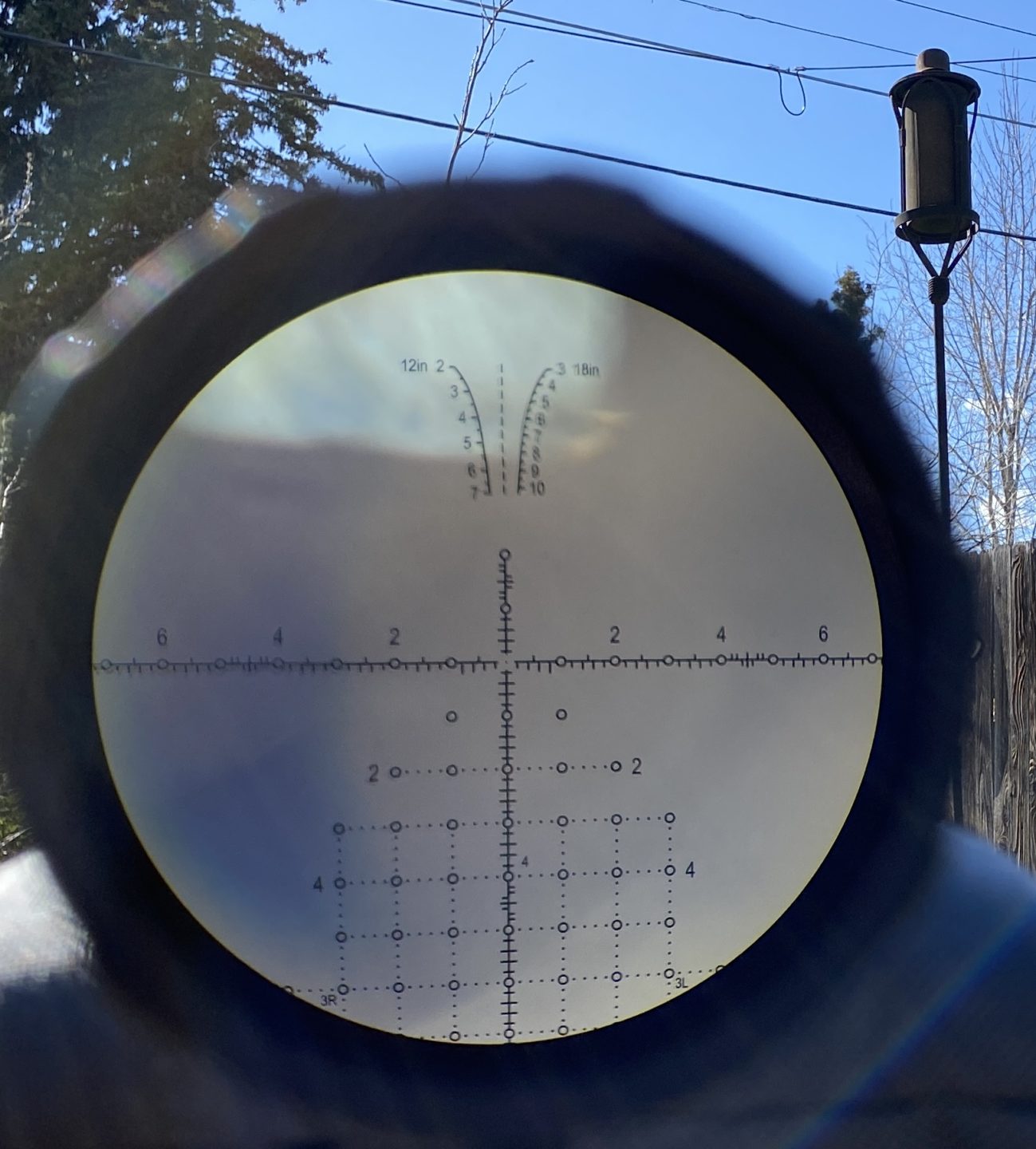
This has to be one of the longest-running debates going. Nobody agrees on the facts, and everyone appears emotionally tied to the choices. Mils vs MOA is not about one system of angular measurement vs the other system, it’s about personal choice and education.
The more you educate yourself on the differences the easier the decision becomes. There are reasons why, and those reasons are often tied to a specific shooting discipline.
If we combine these details with an objective look at our personal shooting, the choices become very clear relatively quickly. When choosing a scope we need to know a few things, your mission, your budget, your experience level, but mostly where do you want to go with it. It’s one thing to shoot alone and manage your equipment its something completely different to be thrown into a situation where the rules are created by someone else. It’s during these times the choices have the biggest impact.
Let’s look at these choices, Millliradians, Minute of Angle and Inch Per Hundred Yards, or Shooter MOA.
Breaking down the Choices
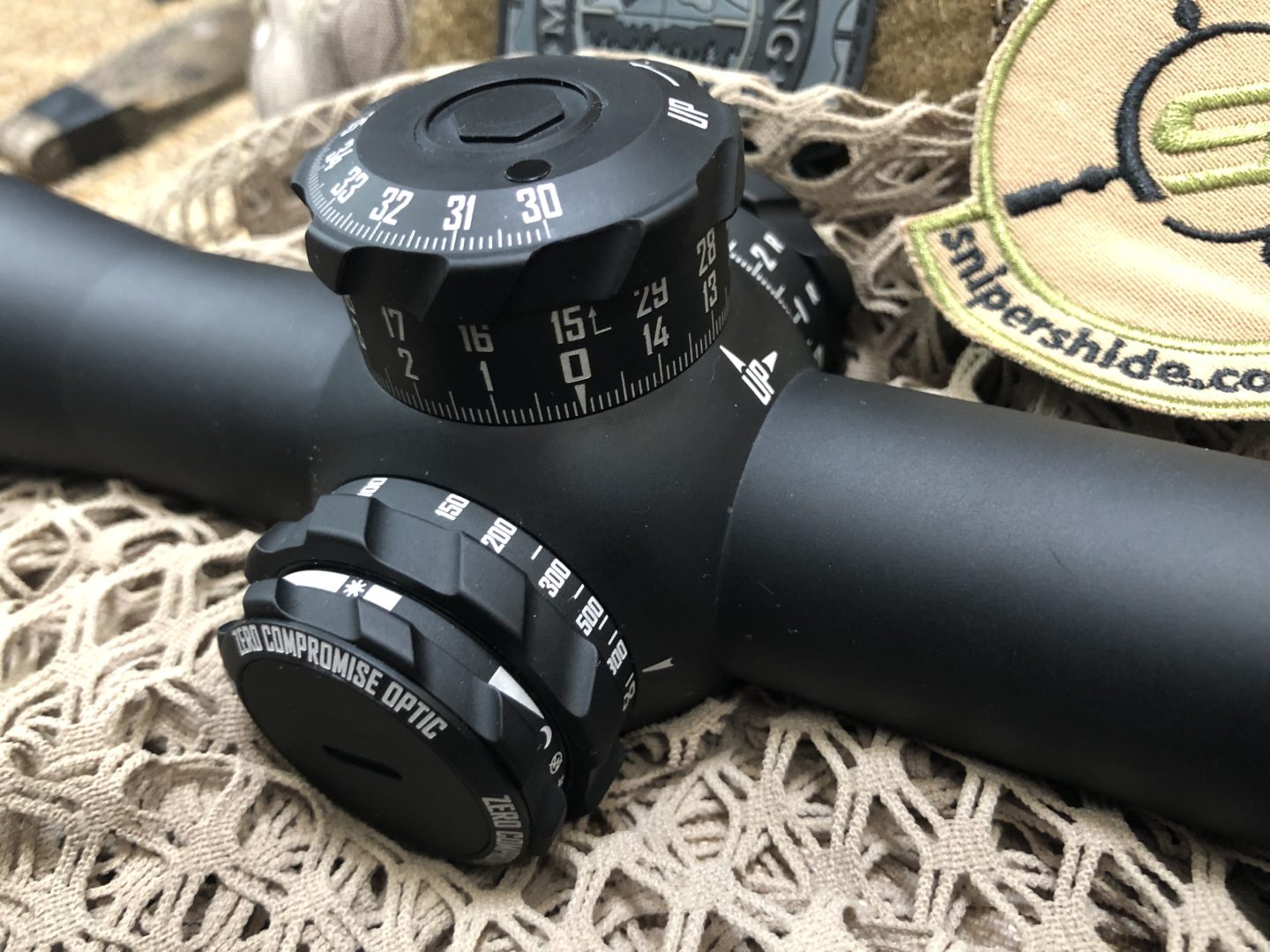
Milliradian’s – Mils – MRAD – Mils are an angle; the angle part is essential to consider because while all angles have a linear equivalent, we do not need the linear values to use Mils successfully.
- An Angle which subtends an arc whose length is 1/1000th of the distance from the vertex.
- 1 yard @ 1000 yards
- 10 centimeter @ 100 meters
- 3.6 Inches @ 3600 inches or 100 yards
Most Mil based scopes adjust in .1 Mils or 1/10th MRAD, which equals .36″ per click @ 100 yards. Some scopes also adjust in .05 Mils or .18″ @100 yards for finer adjustments. When looking at Mils, you can think of money, 10 pennies equal 1 dime, or each click is a penny every full milliradian is a dime. I was also turned on to dimes and dollars. Each click is a dime and whole Mils are dollars. So you can use 63 cents or $6.30 to visualize it. This also works with .05 Mil based scopes because you can use 5 cents per click with 20 clicks being $1 or a Mil.
Milliradians are base 10, so they were added to the Metric System in the 1950s. Angles work with any unit of linear measurement so they are not strictly metric. This usually causes a lot of confusion with American Shooters. .1 MRAD adjustments do line up to 1 centimeter at 100 meters adding to the mess. You can sometimes find higher-end European scopes for less money because they are marked 1CM per Click. This just demonstrates the versatility of an angular unit of measurement.
Pros:
- Base 10 units are easier to work with over fractions
- Wind-based formulas are more natural to use with Mils
- Smaller numbers to remember – Less movement for the same elevation
- Widely used around the globe
- Better Reticle Choices
Cons:
- Highly misunderstood in America
- Actual offset between 1/4 MOA is negligible = .0235MOA
- Needs to be converted using 3.43 when talking MOA
Minute of Angle – MOA – True MOA – TMOA
MOA is an angle just like Milliradians, this angle also has a linear equivalent like any other, so when discussing TMOA, we want to reference the angles, not the inches found between them.
Minute of Angle – is a unit of angular measurement equal to 1/60th of 1 degree.
True MOA = 1.047” at 100 yards.
Pros:
- Different scope adjustment choices: 1/8, 1/4, 1/2, & 1 MOA
- Used in the US for many years
- NRA Paper targets are calibrated in MOA
Cons:
- Misused by many shooters over the years
- Manufacturers mix TMOA with SMOA
- Fractions
- Limited Reticle Choices
- No Standard among Manufacturers – you don’t always have a 1 MOA reference with reticles.
- Larger numbers to remember.
Shooter MOA or Inches Per Hundred Yards
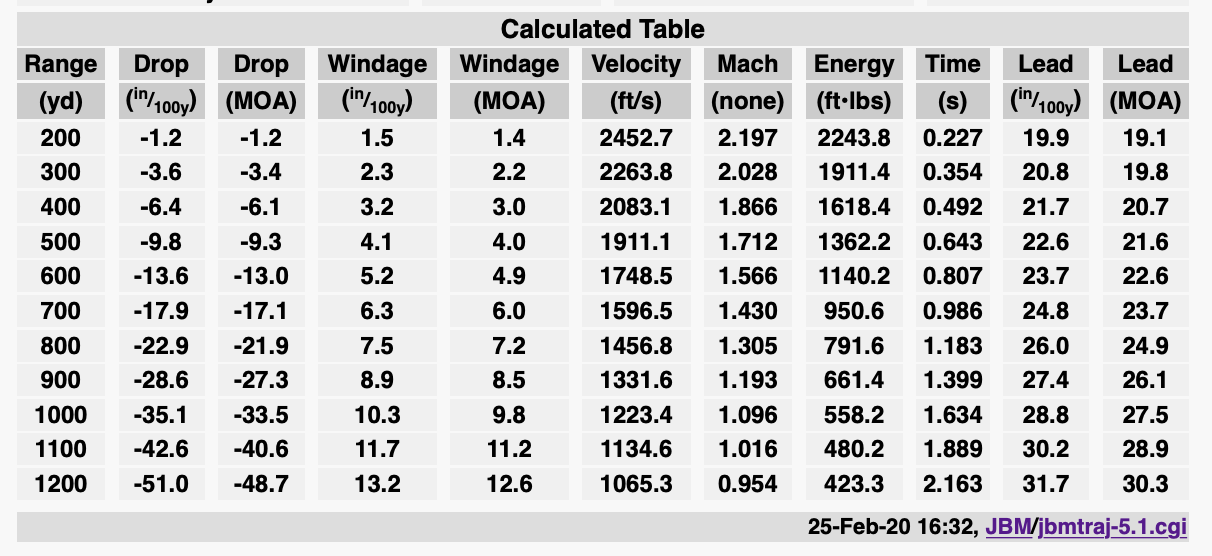
Shooter MOA or IPHY is a modified version of True MOA that rounds the linear value of 1.047″ to 1″ at 100 yards. Changing this was a bit of a mistake made years ago by people shooting mid-range distances. The change created a built-in 4.7% error when mixed with TMOA.
Many errors in setting up ballistic calculators come from mixing SMOA Scopes with TMOA values in the computer. The 4.7% error factor grows at distance, and the farther you shoot, the bigger the error. If you have a scope that lists the adjustment value as .25″ that would be considered IPHY vs a True MOA Scope which adjusts in .26″.
Many of the uninformed state it’s a 1/2″ difference at 1000 yards because 1 MOA at this distance equals 10.47″. While technically true, we do not use 1 MOA to reach 1000 yards we have to combine the adjustments to over 30MOA in most cases. That means the 4.7% error is multiple by 3x if not more depending on the rifle system. At 1000 yards, this can mean as much as 20″ of difference because the software will tell you a number in MOA which compounds. This is a big point of contention because a single MOA is separated by .47″, but because it is Minute of Angle, it is multiplied by the range.
Reference the difference above using JBM and you can see, almost 2 MOA of variation between the two. That multiples to close to 20 inches. You have 35 MOA vs 33 MOA, hence a known source of ballistic calculation errors.
Shooter MOA has to be paired with like values in order to work correctly. The turrets and the reticle must match, and often they are mixed between TMOA and SMOA. This is due to the machining process on the turrets vs the manufacturer of the reticle.
Pros:
- Commonly found in lower-cost scopes
- More straightforward ranging formula than TMOA
Cons:
- 4.7% error when compared to TMOA
- Misunderstood as equal to TMOA at distance.
- Customer Service tells you, Yes, you have an MOA scope without specifying which one of the two.
With MOA and IPHY you have to do a tall target test in order to determine exactly what you have. In many cases, the manufacturer will mix units because of the machining process so be sure to execute a Tall Target Test. It is very common to have a manufacturer list an MOA Scope as .25″ per click. Doing will incur a penalty at longer ranges.
The Practical Side of Shooting
All three systems work when used correctly. For individuals shooting on their own as part of their hobby, the system of adjustment is a minor consideration. However, when branching out to other areas of the sport such as competitions, communication becomes the bigger factor over the others. Most Tactical Shooters communicate in Mils, so MOA shooters have a conversion to consider. In F Class and BenchRest, more shooters use MOA. The targets are calibrated in MOA, and communication on the line is more natural speaking the same language.
On paper, one may appear “finer” than the other; however, broken down when used; the difference is roughly .0235″ between the two. You have less than a bullet width of difference, the likes of which cannot be held by most shooters.
Taken from a mathematical standpoint, this example was recently posted:
Example: You impact 1.346 MOA right of your POA

1/4 MOA Gets us: 1.346 – 1.250 (5 clicks) = .096 MOA away from POA
.1 MRAD or .344 MOA Gets us: 1.346 – 1.376 (4 clicks) = -.030 MOA away from POA (negative just means we are left of the POA now, but still closer to POA then the 1/4 MOA)
The first graph has POI on the X-axis (.002, .004, .006 .. 3 MOA), and the Y-axis is how close you can get to the POA, two plots, one for 1/4 MOA and one for .1 MRAD. We can see (just like the example above) sometimes MRAD is closer to POA then MOA, although not as often. As I calculated it, 1/4 MOA gets you closer ~63% of the time, and . 1 MRAD gets you closer ~36% of the time with about a 1% tie.
The second graph plots the difference between how close 1/4 MOA is vs. how close .1 MRAD is for each POI of .002, .004, .006 … 3.0 MOA.
The beginning of the graph where it is flat is because from 0 to .125, neither 1/4 MOA nor .1 MRAD can get any closer then each-other. The parts in this graph above the X-axis represent when 1/4 MOA is further from the POA then .1 MRAD. And the parts in this graph below the X-axis represent when 1/4 MOA is closer to the POA then .1 MRAD.
The takeaway from the Finer Adjustment debate is: but which one is closer to center, the fact one number is different from the other only means you are missing a significant component of the debate which cannot be determined correctly on paper. We assume ballistic solutions are to the center, rarely are they off enough to miss if properly trued. In short, I can hit a target every bit as easy with a courser adjustment using Mils, there is no real advantage because the adjustment needed is unknown.
If it didn’t work to hit center of any target at any range it would be in service. The debate around adjustments is flawed from the start.
But I “think” in Inches:
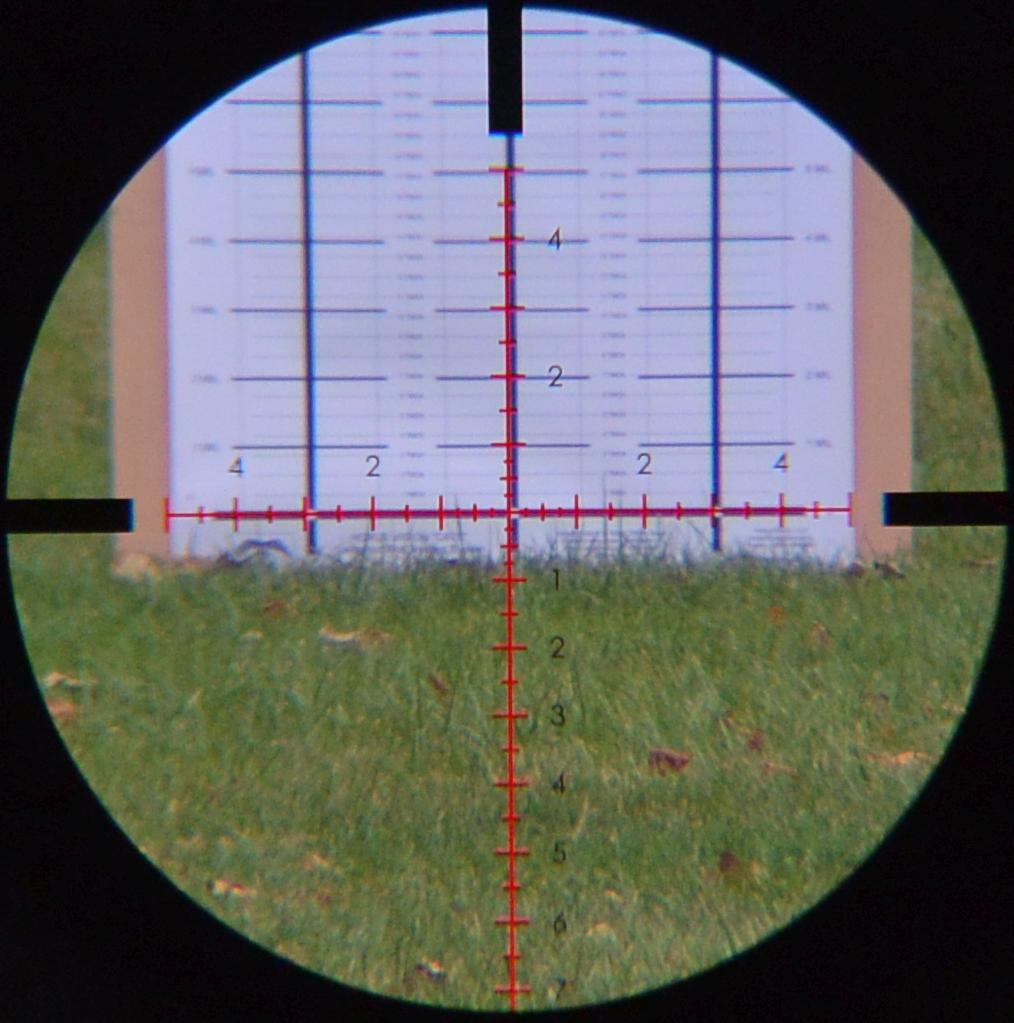
This argument is one of ignorance; we don’t want to think we want to read and communicate in a language that common across the discipline we are shooting. So this is the first significant consideration, we are not thinking about the adjustment we are reading it. The idea you can mix and match inches and MOA is a long-standing one and a big part of the problem. The education of MOA was built around the addition at distance instead of using the angle and teaching that mindset.
Milliradian’s work with inches, yards, and miles the same as MOA. There is no difference in the results just in the communication between the shooter and his system. Many will reference the finer discussion, but mils can subtend very fine also. How you get to the solution is where much of the debate lies.
The “1 MOA is smaller” argument is blunted because .3 Mils = 1.08″ at 100 yards, so you can move that same value as you are moving .36 per .1 adjustment. They are using the definition and not the real world adjustments.
Here is an example of how both work and can be interchanged using simple math.
Actual dope for an 875-yard target or 800m:
- Mils = 6.3
- TMOA = 21.6
- SMOA = 22.6
All three of these can hit the same target under the same conditions. Mils and TMOA can be converted from one to the other using 3.43 as a multiplier or Constant.
- 6.3Mils x 3.43 = 21.6 MOA
- 21.6 MOA / 3.43 = 6.3 Mils
Another area of variation is ranging between TMOA and SMOA.
The 4.5% error has to be considered in the solution.
Ranging Formulas In Yards:
Mils
Range in Yards = Target size Inches x 27.7 / Mils Observed
TMOA
Range in Yards = Target size Inches x 95.5 / TMOA Observed
IPHY / SMOA
Range in Yards = Target size Inches x 100 / SMOA Observed
The work is the same; the issue is usually the reticle. Most MOA based scopes use 2 MOA reticle sub tensions; some do have 1 MOA choices; however, Mil based reticles have a finer sub tension being .1 ranging trees or .2 Sub-tensions.
- .1 Mil = .36”
- .2 Mils = .72”
- 1 MOA Reticles = 1 MOA
- 2 MOA Reticles = 2 MOA
So using the reticle, you have a finer area of adjustment vs. the MOA versions currently offered. This fact splits the finer argument in 1/2.
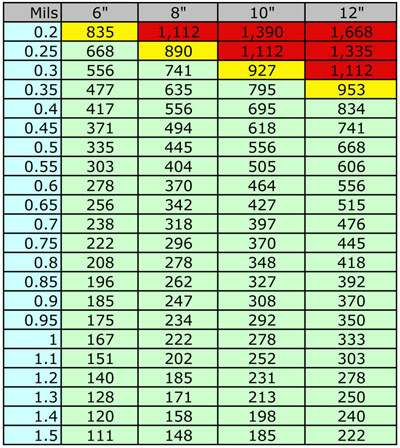
If you look at manufacturers website they often incorrectly list the MOA ranging formulas to read MOA x 100 = Range, when, as noted above, the real constant is 95.5. Given the fact that ranging with a reticle is a skillset that must be mastered, adding an additional 4.5% error to this process is a deal breaker. Ranging with a reticle is a legacy skill, but still a tool for the toolbox, make sure you get it right upfront.
Shooter Mindset

We don’t want to think in inches because, in the first place, you are estimating the number of inches away from the target. Wait, let me say that a different way, you are trying to estimate inches standing 100s of yards away. We have a calibrated ruler 3 fingers in front of our nose. When the reticle matches the adjustments as most scope automatically do today, what you see is what you get. The angles work for you and not against you, use the angle.
Start looking at the reticle like a ruler and measuring based on the unit of adjustment vs. looking downrange and trying to estimate the distance.
In the past, this was taught by compounding the linear value with MOA. They wanted you to use the linear value and multiply by the range. This is meaningless in this sport but instead makes you want to multiply. The mantra was always, 1″ @100, 2″ @200, 3″ @ 300, etc. This gets you thinking without solving the problem. Who cares what the inches are, we want the angular unit of adjustment correction, not the linear distance.
You are basically doing the work twice. You are estimating the number of inches away from the target you impacted. Then you are using that rough estimate to convert the inches to MOA and then adjusting the scope. Instead if you read the reticle in MOA or whatever value you are using, and adjust. You are finished. You read your answer, you did not calculate it.
Just read it in the reticle and say,
I need 2 MOA to hit the center of the target or for a Mil, shooter reading this: .6 Mils off, so just dial.6 Mils, or 2 MOA.
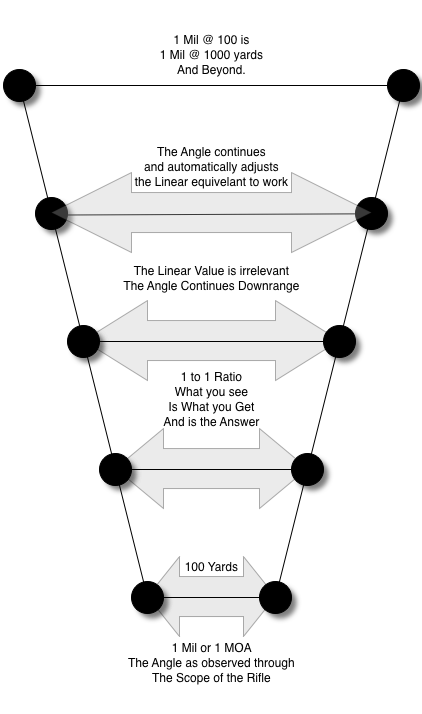
The more you shoot and use the reticle, the easier it will be too overlay the adjustment value to the target. I see misses in the Mils, not inches. I am never trying to determine the linear value only the angular one. I always practice looking at the miss in terms of Mils not inches. Both with a scope and a spotter. A reticle in a spotter can be an invalueable tool.
The Wind
Using Mils is easier to learn wind reading as well. The only valid MOA formulas are based on a specific bullet. There are constants and values that have to be translated to your equipment. The USMC Wind formula most use is based on a 168gr going 2550fps, so those constants are not accurate for modern shooters. To translate the constants to the bullet being used, you need the correct hold to work the formulas in reverse. If you have the correct hold, the formula is not needed. So why are we using it again?
BC Method – MPH Gun
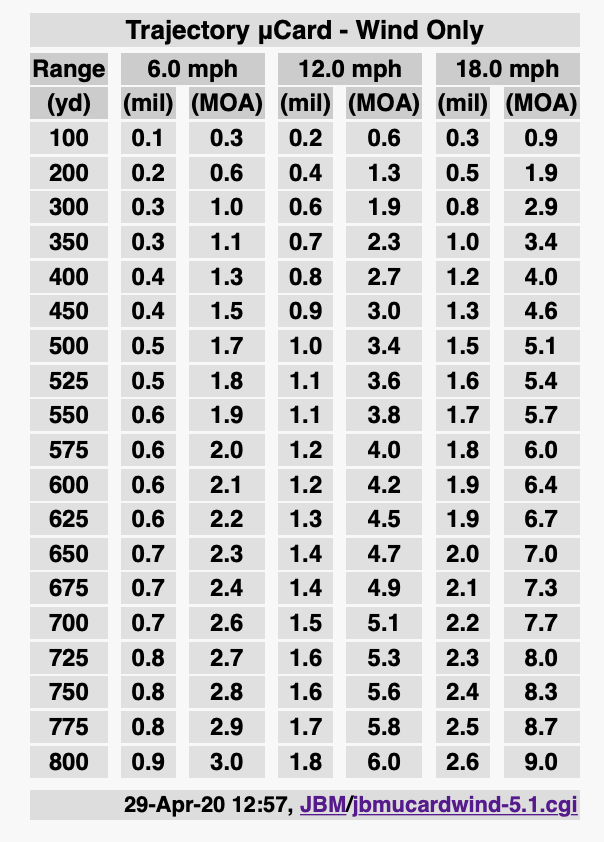
The BC Method, using the first number of the G1 BC to determine Wind Speed for your load.
We can use Mils to determine your MPH Gun, which then accurately lines up the holds based on the range.
143gr ELDX 6.5 Bullet – BC = .625 – 6MPH Gun.
6 MPH Gun @ 6 MPH Full Wind value
- 200 – .2
- 300 – .3
- 400 – .4
- 500 – .5
- 600 – .6
6 MPH Gun @ 12 MPH Full Wind Value
- 200 – .4
- 300 – .6
- 400 – .8
- 500 – 1.0
- 600 – 1.2
This is very easy and accurate, something that works with any bullet combination.
MOA Wind – British Method
The British Method is again using a specific bullet, so understand this limitation.
10 MPH wind is your base wind.
1 MOA @ every 100 yards
Wind MPH 2-3 MPH = light, 5MPH = medium
10MPH = base, 20MPH = heavy
Example
- Range 600, velocity 10mph = 6 MOA
- Range 600, velocity 5 mph = 3 MOA
- Range 600, velocity 2-3mph=1.5 MOA
- Range 600, velocity 20 mph = 12 MOA
This will work with limited success because it is based on a specific bullet. The shooter needs to know the correct wind call in order to work these formulas backward.
You can convert the MPH Gun to MOA, but it is much more complicated. Simplicity is the real winner when it comes to shooting.
Using Clicks
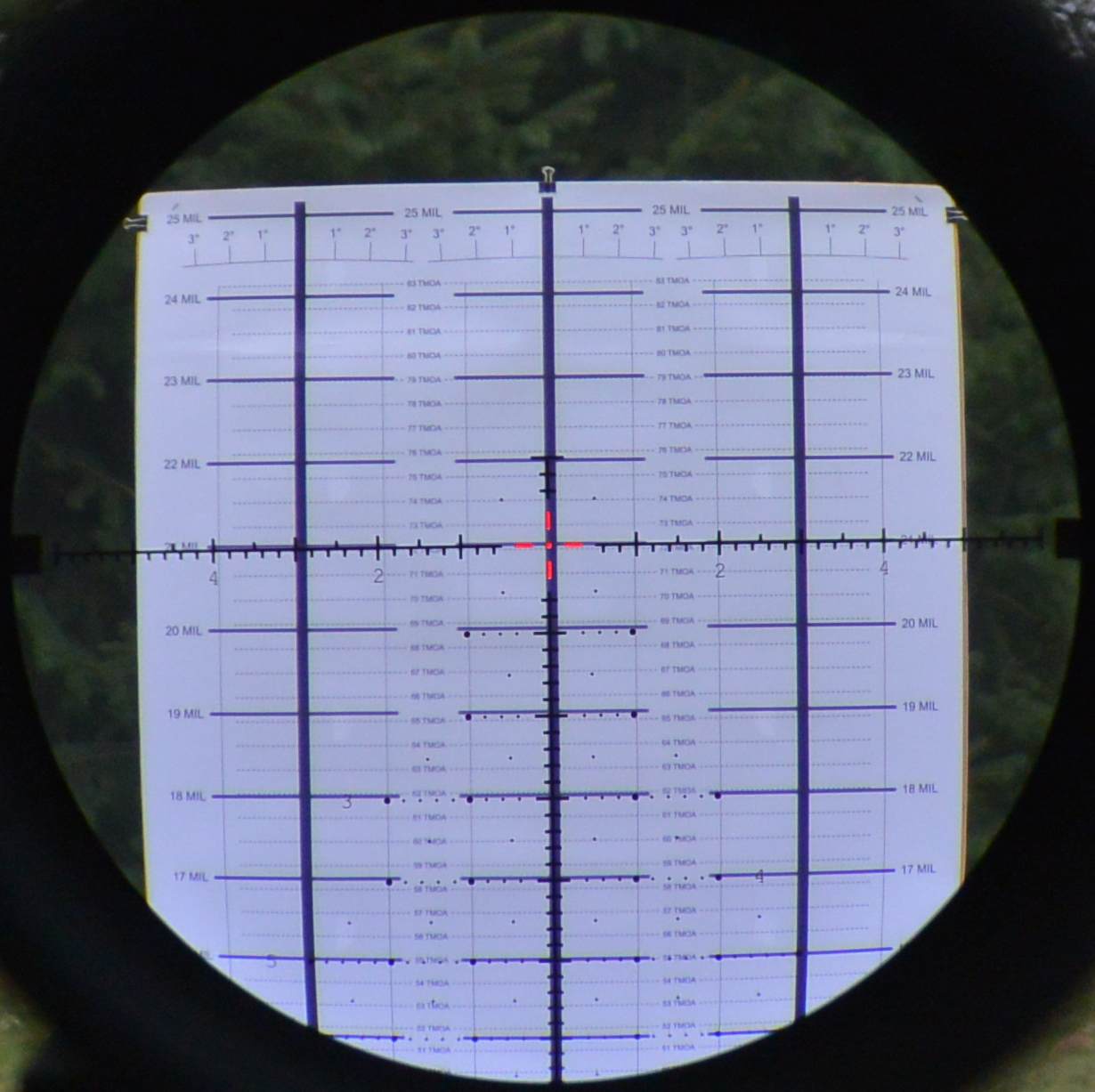
Clicks are not a good way to communicate. It goes against the principles of speed and simplicity. It’s better to speak in the correct language vs. Shorthand in this case because it’s really longhand cursive.
Dial on 20.6 MOA vs. 83 clicks; this immediately gets the brain overthinking.
6.3 Mils = 63 clicks, what is easier counting 63 pennies or 63 cents in dimes?
Use the whole number first; then fine-tune it,
Dial to 20, then add in .6 MOA, which is 3 clicks.
Dial to 6, then add in .3 Mils, which is 3 clicks.
On a firing line with different shooters, who can potentially be using different click values, you have to know that click value to give the appropriate number. If you are using 1/2 MOA adjustments, that value is different from 1/4 MOA adjustments in terms of clicks.
The only time you see clicks work is adding one or two more. “Come up a click” that adjustment is so small it’s easiest to address in this fashion. However, a 5 MOA change referenced via clicks is coming off wrong.
Speaking in clicks beyond one or two should be dismissed as bad practices.
Making a Final Choice
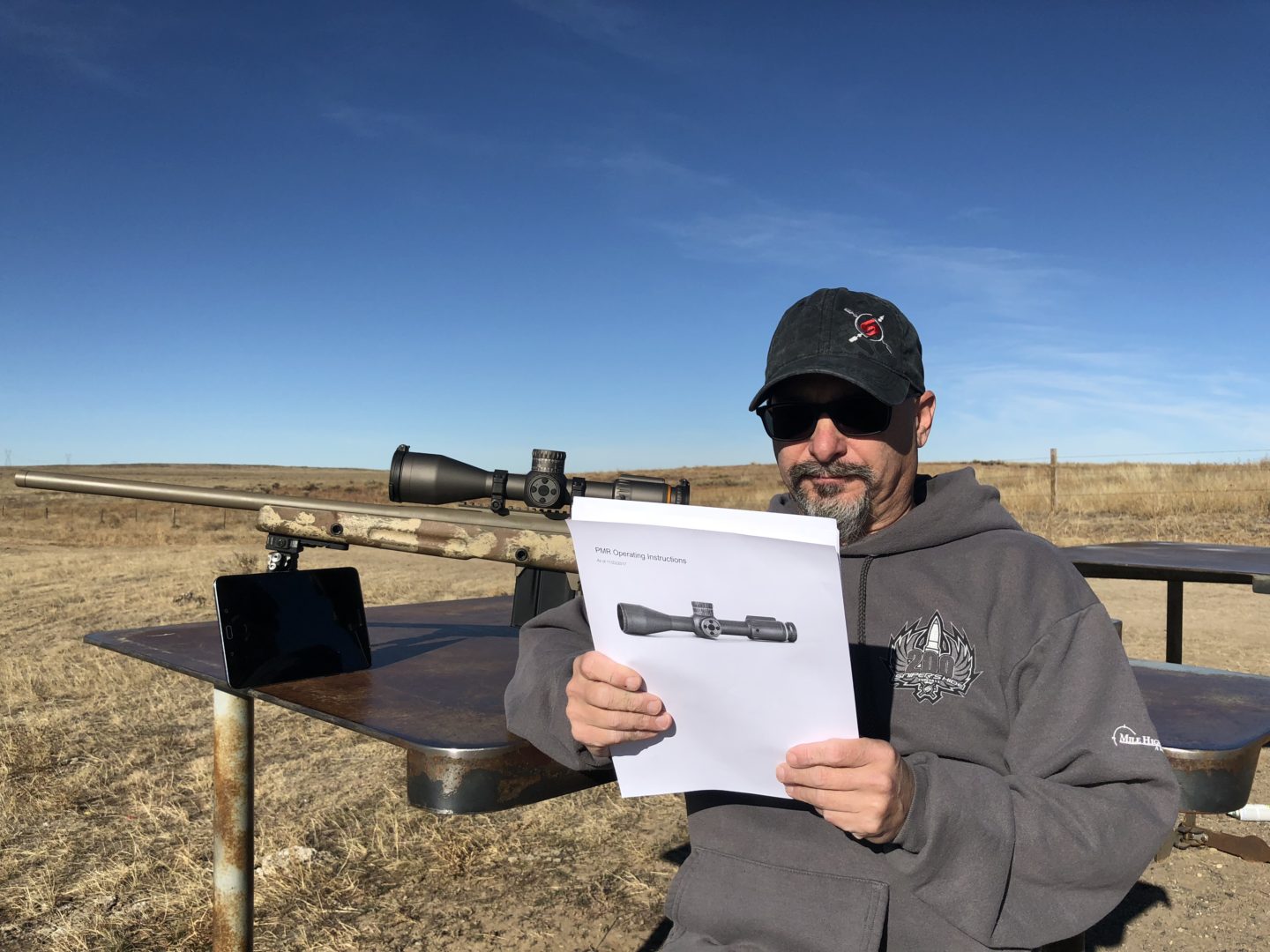
It’s about education, it’s about making smart choices and not just repeating old wives’ tales from the 1970s. We are better shooters, better educated on the theories, and have access to more resources than ever before. Use these tools to make informed decisions.
Pick the unit of adjustment based on your needs not the needs of someone else. Imagining asking for advice on a new truck for work and the response you get is to buy a sports car because everyone had great luck going to work in it. The reticle should speak to the end-user as that is what you are interacting with, the reticle. We made adjustments on the turrets and those adjustments will work regardless. However how we interact with the reticle and target relationship matters. Are we comfortable with what we are looking at because the brain will rebel if you are not? We see mistakes made all the time because the brain refuses to play a game it doesn’t like.
Competition shooters have a choice to make, communication and target packages are the first consideration. If everyone on the line is speaking in Mils and you are holding out with MOA, you have to translate. If you are shooting an F Class match and decide to Mils because that is what you have, know the targets are calibrated in MOA. The field will be communicating in MOA so there is a translation to be made.
If the optic you picking is confused about whether it wants to you adjust in Inches or MOA, you might want to pick a brand that knows what it is doing. Many of these scopes today are OEM pieces. The manufacturer does not care if it mixes or matches. If the brand is not specific and the OEM fills in its own blanks or cuts corners, you have a divided system. Reticles in True MOA because the process is fine, vs IPHY turrets because the machining is easier.
Define the Mission

Back in the day, prior to ballistic computers, we doped our rifles on the firing line. What we shot is what we recorded. That made the data real-world accurate. Today with software people are just defaulting to MOA without paying attention and then wonder why their predictions are so far off. Because you told the computer you have a TMOA scope but it’s really IPHY. We used to use Shooter MOA or True MOA, today it’s all blended together. This is a volume problem that Mils have avoided.
For Tactical/Practical Shooters I think Mils is the better choice. It’s easier more intuitive and gives you easy numbers to remember. Even hunters can benefit from it much in the same way the Military has moved to Mils. It’s Iron Sights, the Benchrest crowd, or F Class shooters that keep MOA relevant today.
I speak both languages fluently, which means I am fine either way, but experience has taught me Mils are easier and every bit as effective. I like the ecosystem Mils lives in more so than MOA. That said, don’t base your decision on my decision, base your decision on your needs and understandings.
Lastly, we find those who switch from MOA to Mils fare very well. It’s a tiny learning curve as the numbers are much easier to work with. Do your homework, understand your mission, and drive on.
Use this breakdown to enhance your buying decisions.
#snipershide
#precisionrifleshooting
#everdaysniperpodcast

